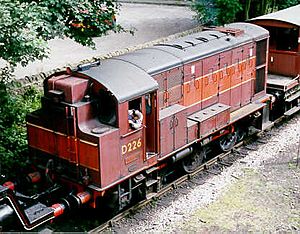British Railways D0226 facts for kids
Quick facts for kids British Railways D0226 |
|
 |
|
| D0226 at Haworth. | |
| Power type | Diesel-electric |
|---|---|
| Builder | English Electric at Vulcan Foundry |
| Serial number | English Electric: 2345 Vulcan Foundry: D226 |
| Build date | 1956 |
| Configuration | 0-6-0 |
| UIC classification | C |
| Wheel diameter | 4 ft 0 in (1.219 m) |
| Locomotive weight | 48 long tons (49 t) |
| Prime mover | EE 6RKT |
| Transmission | DC generator, DC traction motor |
| Top speed | 35 mph (56 km/h) |
| Power output | 500 hp (370 kW) |
| Tractive effort | 33,000 lbf (146.79 kN) |
| Career | British Railways |
| Number | D226 (D0226 from August 1959) |
| First run | loaned 1957 |
| Retired | October 1960 |
| Disposition | to Keighley and Worth Valley Railway (March 1966) |
| British Railways D0227 | |
| Power type | Diesel-hydraulic |
|---|---|
| Serial number | English Electric: 2346 Vulcan Foundry: D227 |
| Transmission | Krupp-Lysholm hydraulic |
| Career | British Railways |
| Number | D227 (D0227 from August 1959) |
| Retired | September 1959 |
| Disposition | Returned to RSH, Darlington |
D0226 and D0227 were two special test trains, called prototype diesel locomotives. They were built in 1956 by a company called English Electric at their factory, Vulcan Foundry, in Newton-le-Willows, England. These locomotives were made to show British Railways what English Electric could build.
These trains were designed for shunting. Shunting means moving railway cars or locomotives around in a train yard. They originally had the numbers D226 and D227. Later, their numbers were changed to D0226 and D0227. This was done to avoid confusion with other new trains, like the Class 40 locomotives, which also used similar numbers.
Contents
Meet the Prototype Locomotives
These two locomotives were built to test different ways of powering a diesel train. They were like experiments to see which design worked best.
D0226: The Diesel-Electric Train
D0226 was a diesel-electric locomotive. This means it used a diesel engine to power a generator. The generator then made electricity, which powered electric motors connected to the wheels. It was built in 1956 and loaned to British Railways in 1957. D0226 was retired in October 1960. Later, in March 1966, it was sent to the Keighley and Worth Valley Railway, where it is now preserved.
D0227: The Diesel-Hydraulic Train
D0227 was different. It was a diesel-hydraulic locomotive. Instead of using electricity, its diesel engine powered a special hydraulic system. This system used fluid pressure, similar to how a car's automatic gearbox works, to turn the wheels. D0227 was also built in 1956. It was retired earlier than D0226, in September 1959. After its tests, it was returned to its builders.
Images for kids


